| Columns Retired Columns & Blogs |
This Plitron (not Piltron, probably a typo) is a 1.5 kVA toroidal according to the technical department at Pass Labs.
The big Pass Labs XA160 ran very warm, its chassis being almost too hot to touch after the usual one-hour preconditioning at one-third power (53W) into 8 ohms. Interestingly, the distortion rose very slightly during that period, from 0.14% to 0.2%, but as it plateau'd rather than continuing to rise, I imagine this reflects the amplifier's transfer function settling in as the active devices came up to their operating temperatures.
The XA160's voltage gain into 8 ohms was 26.25dB for both balanced and unbalanced signals. (I shorted pins 1 and 3 of the XLR jack for unbalanced drive.) The amplifier preserved absolute polarity, and its input impedance at 1kHz was quite low, at 19.5k ohms balanced and 12.7k ohms unbalanced. Tube preamplifiers with highish source impedances at low frequencies are best avoided.
The output impedance was both higher than specified and quite high for a solid-state design, at 0.57 ohm over most of the audioband, rising to 0.8 ohm at 20kHz. As a result, the Ohm's Law frequency-response interaction between this source impedance and the manner in which a speaker's impedance changes with frequency is more like a tube amplifier's, reaching ±0.5dB with our simulated speaker load (fig.1, top trace).
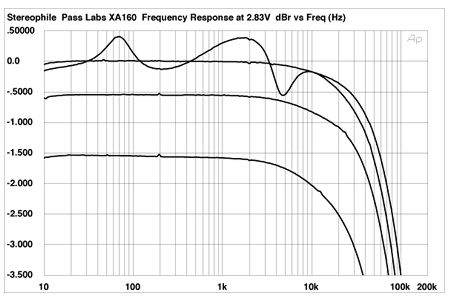
Fig.1 Pass Labs XA160, balanced frequency response at (from top to bottom at 2kHz): 2.83V into simulated loudspeaker load, 1W into 8 ohms, 2W into 4 ohms, 4W into 2 ohms (1dB/vertical div., right channel dashed).
The ultrasonic response is sensibly rolled-off, reaching -3dB at 91kHz, though this results in 0.35dB of rolloff at 20kHz. This was into 8 ohms; the rolloff was more severe into lower impedances, with the 20kHz response almost 1dB down into 2 ohms (fig.1, bottom trace). As a result, a 10kHz squarewave is reproduced with a slight slowing of its leading edges (fig.2). However, I don't think this behavior correlates with the "warm, sweet" balance noted by MF in his auditioning, given the fact that the Wadia digital processors featured a 20kHz rolloff three times greater without sounding too dark.
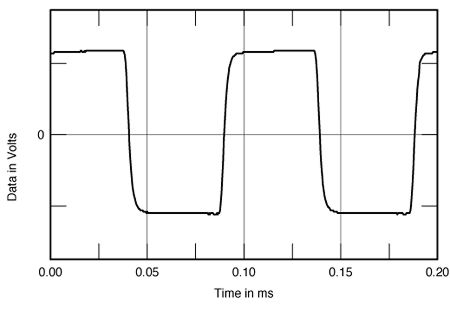
Fig.2 Pass Labs XA160, small-signal 10kHz squarewave into 8 ohms.
To my surprise, given its bulk, the XA160 didn't meet its specified output power of 160W into 8 ohms. I checked both samples, which measured the same, then re-measured them using a Neutrik generator and an analog oscilloscope, in case there was some incompatibility between the Pass Labs and my Audio Precision System One. The result was no different.
Fig.3 shows how the XA160's measured THD+noise percentage changes with measured output power. (The wall AC voltage was 124V for these measurements.) The actual output power at clipping (defined as 1% THD+N) was 165W into 16 ohms, 118W into 8 ohms, 59W into 4 ohms, and 29W into 2 ohms. As I've said, the two amps measured virtually identically in this respect, meaning that this is unlikely to be due to a sample fault. [A subsequent e-mail from Nelson Pass concerned the fact that early samples of the amplifier suffered from a production error, resulting in the low maximum power. This has been corrected, Iw as told.—JA.]
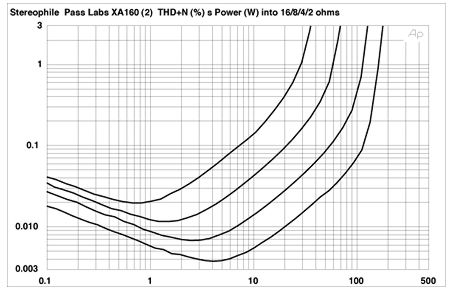
Fig.3 Pass Labs XA160, distortion (%) vs 1kHz continuous output power into (from bottom to top at 10W): 16 ohms, 8 ohms, 4 ohms, 2 ohms.
The shortfall in power delivery into 8 ohms is 1.3dB, which is not really much of a difference. However, the Wilson WATT/Puppy 7 speaker used by MF for his auditioning is basically a 4 ohm load, so I'm somewhat surprised that the Pass Labs amplifiers didn't sound as if they were running out of power. All I can think of is that 60W is still enough power for the Wilsons to reach satisfyingly loud levels in his room. But as all these power figures (other than the 16 ohm result) are equivalent to a current of 3.8A—way below the 12A specified—it looks as if the XA160's clipping-free power delivery is current-limited. Combinations of low-impedance speakers and large rooms should be avoided with the XA160.
Fig.3 also indicates that the XA160's linearity worsens with increasing current demand and decreasing load impedance. This can be seen in fig.4, which plots the XA160's THD+noise percentage against frequency at 2.83V into 2 through 16 ohms. The bottom two traces, into 16 and 8 ohms, almost overlay, suggesting that the actual distortion components are below the already low noise floor at this level. And at around 0.08% over most the band, the XA160 is obviously a very linear device. But note the almost doubling of the THD+N percentage into 4 ohms, and an even larger increase into 2 ohms. Yes, it is true that, even into 2 ohms, the distortion is well below 0.1% and is unlikely to be audible, given its low-harmonic nature (see later), which will tend to be subjectively benign. But it does suggest that the XA160's transfer function is modulated by the load impedance to a greater extent than normal, presumably due to its limited use of global negative feedback.
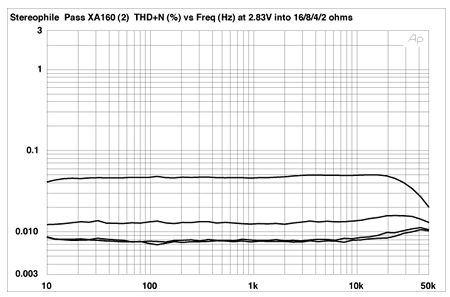
Fig.4 Pass Labs XA160, balanced THD+N (%) vs frequency (from bottom to top at 2kHz): 2.83V into 16 ohms, 8 ohms, 4 ohms, 2 ohms.
That the distortion comprises predominantly low harmonics is shown in fig.5, taken at 6W into 8 ohms. It appears to be almost pure third-harmonic, though spectral analysis indicates that the second, fourth, and fifth harmonics are also present (fig.6). Halving the load brings up the level of the harmonics (fig.7) but leaves their proportions relatively unchanged.
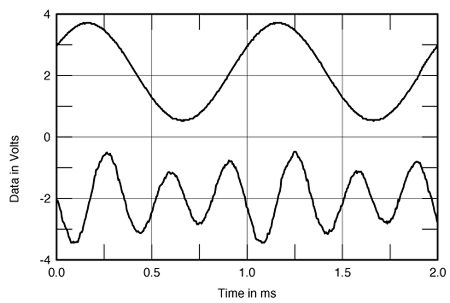
Fig.5 Pass Labs XA160, 1kHz waveform at 6W into 8 ohms (top), 0.06% THD+N; distortion and noise waveform with fundamental notched out (bottom, not to scale).
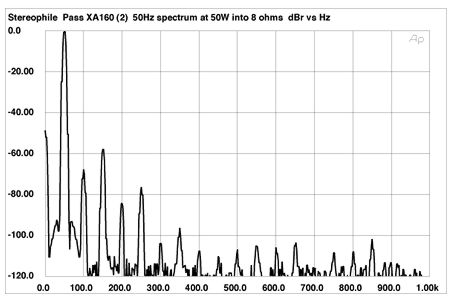
Fig.6 Pass Labs XA160, spectrum of 50Hz sinewave, DC-1kHz, at 50W into 8 ohms (linear frequency scale).
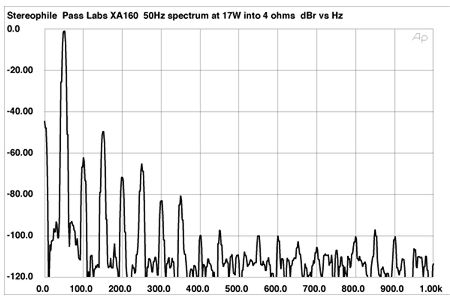
Fig.7 Pass Labs XA160, spectrum of 50Hz sinewave, DC-1kHz, at 17W into 4 ohms (linear frequency scale).
With its somewhat bent transfer function at high output currents, the XA160's performance on my usual high-frequency intermodulation distortion test was only moderately good (fig.8), the 1kHz difference component reaching -64dB (0.06%).
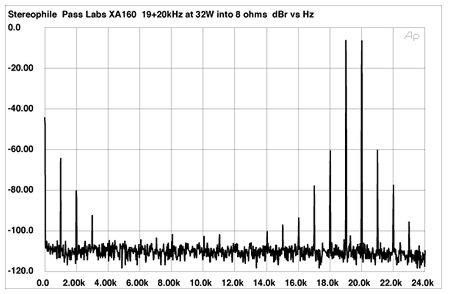
Fig.8 Pass Labs XA160, HF intermodulation spectrum, DC-24kHz, 19+20kHz at 32W into 8 ohms (linear frequency scale).
The Pass Labs' measured performance left me scratching my head. Its massive construction, high heat output, and high price suggest a limitless delivery of watts—yet, assuming neither review sample was malfunctioning, the XA160 offers only moderate power. Its current-limiting of the clipping points is also something that historically has been regarded as a bad thing in a solid-state power amplifier. But like its highish output impedance, this is something that is more typical of tube designs, which might well go some way to explaining why MF felt the XA160 to sound like a tube amplifier.—John Atkinson

This Plitron (not Piltron, probably a typo) is a 1.5 kVA toroidal according to the technical department at Pass Labs.